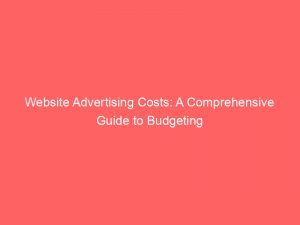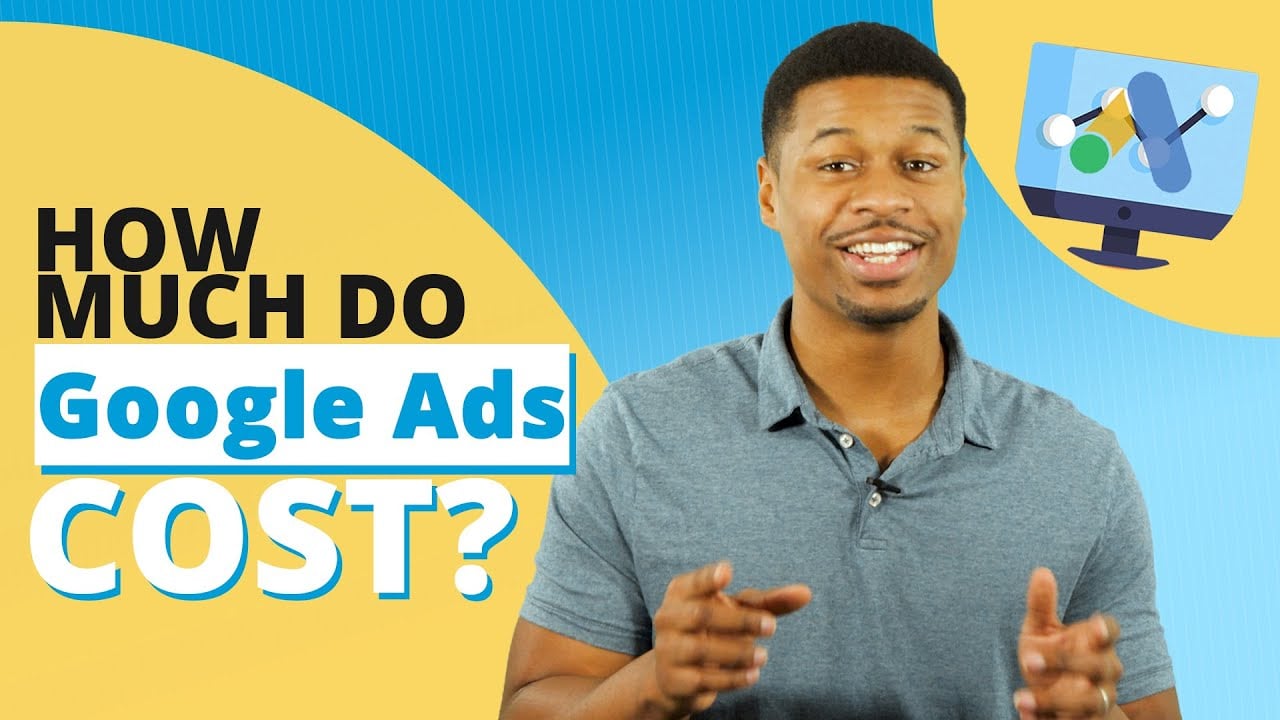- website advertising costs
- 1. Overview: Variations In Online Advertising Costs
- 2. Online Advertising Budgets: Marketers Spending Trends
- 3. Small Business Advertising Costs On The Web
- 4. Pay-Per-Click (PPC) Advertising Pricing
- 5. Social Media Advertising Costs
- 6. Flexibility And Control: Customizing Online Advertising Budgets
- 7. Pricing For SEO Services
- 8. Costs Of Email And Content Marketing Services
- In conclusion,
In the vast and ever-changing world of online marketing, one crucial consideration remains constant: the cost. As businesses strive to maximize their reach and attract the attention of potential customers, the realm of website advertisingcosts has become a tantalizing enigma.
How much should one invest? What channels provide the best returns?
The answers lie in the intricate dance of algorithms, ad placements, and campaign sizes. Today, we embark on a journey to unravel this mysterious realm, where a few clicks may bear the weight of a fortune, and where success is often as elusive as the whisper of a dollar bill.
Join us as we dive deep into the captivating world of website advertisingcosts.
| Item | Details |
|---|---|
| Topic | Website Advertising Costs: A Comprehensive Guide to Budgeting |
| Category | Marketing |
| Key takeaway | In the vast and ever-changing world of online marketing, one crucial consideration remains constant: the cost. |
| Last updated | December 28, 2025 |
advertising-costs">website advertising costs
Website advertising costs vary depending on various factors such as channels and campaign size. In 2023, marketers spent a total of $856 billion on onlineadvertising.
Small and medium-sized businesses (SMBs) typically pay between $2500 and $12,000 per month for onlineadvertising. Pay-per-click (PPC) advertising usually has an average cost per click (CPC) of $1-$2.
Social media advertising platforms range from $0.38 to $5.26 per click. Businesses have control over their advertising budget and can experiment with different channels.
SEO costs range from $750 to $2,000 per month, while email marketing ranges from $9 to $1,000 per month. Content marketing services can cost between $2,000 and $10,000 per month.
Choosing the appropriate online advertising channels depends on the target audience and budget. Comparatively, online advertising is generally more affordable than offline advertising.
Offline advertising costs can be significantly higher and may reach a larger, more general audience, while online advertising offers customization, payment for user actions, flexible budgets, and advanced targeting options.Key Points:
- Website advertising costs can vary depending on factors such as channels and campaign size.
- In 2023, marketers spent $856 billion on online advertising.
- Small and medium-sized businesses (SMBs) typically pay between $2500 and $12,000 per month for online advertising.
- Pay-per-click (PPC) advertising has an average cost per click (CPC) of $1-$2.
- Social media advertising platforms range from $0.38 to $5.26 per click.
- Offline advertising costs can be significantly higher, while online advertising offers customization, flexible budgets, and advanced targeting options.
Sources
https://www.webfx.com/digital-advertising/pricing/how-much-does-it-cost-to-advertise-online/
https://www.topdraw.com/insights/is-online-advertising-expensive/
https://www.wordstream.com/blog/ws/2017/07/05/online-advertising-costs
https://www.webfx.com/digital-advertising/pricing/
Check this out:
💡 Pro Tips:
1. Consider cost-effective alternatives: In addition to paid online advertising, explore other cost-effective strategies like social media organic reach, content marketing, and email newsletters to maximize your budget.
2. Track and analyze campaign performance: Use analytics tools to track the performance of your online advertising campaigns. Analyzing data such as click-through rates, conversions, and ROI can help you optimize your budget and maximize results.
3. Leverage remarketing campaigns: Implement remarketing campaigns to target users who have previously shown interest in your website or products. This can be a cost-effective way to re-engage potential customers and increase conversions.
4. Optimize landing pages: Ensure that your landing pages are optimized for conversions to get the most out of your advertising spend. Improve page load times, create clear call-to-actions, and provide relevant and engaging content to increase conversion rates.
5. Test and refine your campaigns: Continuous testing and refinement of your online advertising campaigns is essential. Experiment with different messaging, visuals, targeting options, and ad placements to find the most effective combination for your audience and budget.
1. Overview: Variations In Online Advertising Costs
Online advertising costs can vary greatly depending on various factors such as the channels used and the size of the advertising campaign.
Businesses have a range of options when it comes to online advertising, each with its own costs and benefits.
One of the most significant factors affecting online advertising costs is the type of advertising campaign. Different channels offer different pricing structures, targeting options, and reach.
For example, Pay-Per-Click (PPC) advertising, social media advertising, email marketing, and search engine optimization (SEO) all have their own cost structures.
Additionally, the size of the advertising campaign can also greatly impact the overall cost. Larger campaigns generally require more resources, such as ad space, creative development, and targeting capabilities, which can drive up the costs.
2. Online Advertising Budgets: Marketers Spending Trends
In recent years, online advertising has become an increasingly important aspect of marketing strategies, leading to a significant increase in overall spending.
According to research, marketers spent a staggering $856 billion on online advertising in 2023.
This increase in spending can be attributed to the growing importance of digital channels and the ever-expanding reach of the internet. As businesses strive to reach and engage with their target audience online, they are willing to invest more in online advertising to achieve their goals.
Optimized content based on recent advertiser behavior.
3. Small Business Advertising Costs On The Web
Small and medium-sized businesses (SMBs) are a vital part of the economy and often have limited advertising budgets.
The costs of online advertising can vary for SMBs depending on several factors, such as the channels used and the size of the campaign.
On average, SMBs typically pay between $2500 to $12,000 per month for online advertising. This range allows SMBs to choose a budget that aligns with their specific goals and resources.
By carefully managing their online advertising budget, SMBs can effectively target their desired audience and maximize the return on their investment.
4. Pay-Per-Click (PPC) Advertising Pricing
Pay-Per-Click (PPC) advertising is a popular and effective online advertising method where advertisers pay for each click on their ads.
The average cost per click (CPC) for PPC advertising typically ranges from $1 to $2 per click.
PPC advertising allows businesses to have control over their budget by setting a daily or monthly limit on how much they are willing to spend. This flexibility makes it an attractive option for businesses of all sizes.
Additionally, PPC advertising offers advanced targeting options, allowing businesses to reach their desired audience with precision.
- Control over budget
- Advanced targeting options
- Payment only for user actions
5. Social Media Advertising Costs
Social media platforms have become powerful advertising channels, offering businesses the ability to target specific demographics and engage with their audience in a more personal way.
The cost per click (CPC) for social media advertising can vary depending on the platform.
Platforms such as Facebook, Twitter, and Instagram have CPCs ranging from $0.38 to $5.26. This range allows businesses to choose the platform that aligns with their target audience and fits within their advertising budget.
Social media advertising also offers advanced targeting options, enabling businesses to reach their desired audience based on interests, demographics, and behavior.
6. Flexibility And Control: Customizing Online Advertising Budgets
One of the advantages of online advertising is the flexibility and control it offers businesses.
Unlike traditional offline advertising, online advertising allows businesses to have full control over their advertising budget.
Businesses can experiment with different channels, adjust their spending, and optimize their advertising campaigns based on real-time data and results. This flexibility enables businesses to make data-driven decisions and maximize the effectiveness of their advertising efforts.
7. Pricing For SEO Services
Search Engine Optimization (SEO) is an essential component of online advertising, as it helps businesses improve their visibility on search engines and drive organic traffic to their website.
SEO costs can vary depending on the scope of the project and the level of competition in the industry.
On average, SEO services can range from $750 to $2,000 per month. These costs cover various activities such as keyword research, on-page optimization, link building, and content creation.
Investing in SEO can help businesses improve their search engine rankings, increase website traffic, and ultimately, generate more leads and sales.
8. Costs Of Email And Content Marketing Services
Email marketing and content marketing are highly effective strategies for businesses to engage with their audience and build long-term relationships.
The costs of these services can vary depending on several factors, such as the size of the email list or the complexity of the content marketing campaign.
Typically, email marketing costs range from $9 to $1,000 per month. These costs may vary based on the number of subscribers, frequency of communication, and the required level of automation and personalization.
On the other hand, content marketing services, which include creating and promoting valuable content, can cost between $2,000 to $10,000 per month. The variation in costs is determined by factors such as the volume of content produced, the level of expertise required, and the complexity of the distribution channels.
In conclusion,
Choosing the right online advertising channels depends on the target audience and the budget available. While offline advertising may reach a larger, more general audience, online advertising offers customization, payment for user actions, flexible budgets, and advanced targeting options.
Online advertising is also generally more affordable than offline advertising.
Businesses have control over their advertising budget and can experiment with different channels to find the most effective strategies for their specific goals. By understanding the costs associated with different online advertising methods, businesses can make informed decisions and allocate their resources effectively.
With the right approach and budgeting, businesses can leverage online advertising to drive growth and achieve their marketing objectives.
Performance Marketing Tips • Native Ad Network • Advertising Platform for Marketers • Buy Traffic











